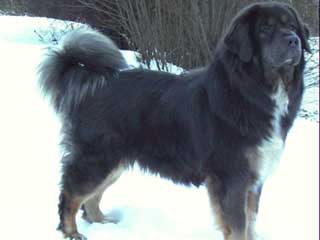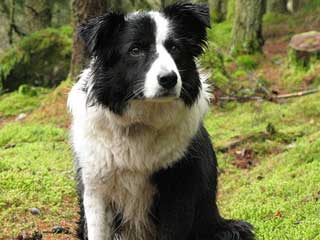| Grooming: |  |  |  |  |  |  |
| Shedding: |  |  |  |  |  |  |
| Energy Level: |  |  |  |  |  |  |
| Protection: |  |  |  |  |  |  |
| Watch Dog: |  |  |  |  |  |  |
| Group: | Working |
| Size: | Large |
| Life Span: | 12-14 years |
| Height: | Male: 26-30 inches |
| Female: 24-28 inches | |
| Weight: | Male: 150-170 lbs |
| Female: 140-160 lbs |
Tibetan Mastiff Facts
| Coat : | Outer coat is heavy, thick & coarse. Undercoat is soft & dense |
| Gait : | Steady and well balanced |
| Color(s) : | Black, brown, & blue or grey, all with or without tan markings, & also different shades of gold |
| Living Area : | Average |
| Hair Length: | Long |
| Exercise Need : | Daily long walk |
| Recognized By : |
(CKC) Canadian Kennel Club (FCI) F�d�ration Cynologique Internationale (KCGB) Kennel Club of Great Britain (NKC) National Kennel Club (NZKC) New Zealand Kennel Club (APRI) America Pet Registry, Inc. (ACR) American Canine Registry (DRA) Dog Registry of America (AKC) American Kennel Club |
| Date of Origin : | Ancient |
| Place of Origin : | Tibet |
| Todays Use : | Guard dog |
| Originally Used : | Guard dog |
| Other Name : | Do-Khyi, Tsang-khyi |
Tibetan Mastiff Information
Tibetan Mastiff Description:The Tibetan Mastiff is one of the oldest dog breeds in the world. Although the exact origin of the breed is unknown, the breed is thought to date back to 11th century. The breed is believed to have descended from the Tibetan Mountain dogs in the Himalayan region after it was left isolated. The popularity of the breed soared in the 18th century when Queen Victoria adopted one of these dogs. However, at the same of the First World War, the numbers of this breed began to dwindle. After dedicated breeding programs, the breed again grew in prominence in the late 20th century in the United States. It remains a rare breed in Tibet, although it is popular in the United States as well as the UK. The breed was first recognized by the AKC in 2006. |
Tibetan Mastiff Care & Grooming:The Tibetan Mastiff is a seasonal shedder. Its long and thick coat needs regular grooming. Brushing its coat 3-4 times in a week with a firm bristle brush and almost daily brushing during shedding season is sufficient to maintain a healthy looking coat. It should be bathed only when necessary and must be dried properly after each bath. However, extra care should be taken of its feet since it is a heavy breed and a lot of pressure is put on the feet. Regular trimming of the nails is advised to avoid injuries. Its eyes and ears should be cleaned properly to avoid any infection. The hair around its ears, eyes and paws should also need to be trimmed regularly. |
Tibetan Mastiff Health Problems:The Tibetan Mastiff is prone to some health issues like hip Dysplasia, Heart problem, Epilepsy, PRA (progressive retinal atrophy), Cataract, Canine Inherited Demyelinative Neuropathy, Skin and ear infections etc. |
| Group: | Toy |
| Size: | Small |
| Life Span: | 12-15 years |
| Height: | Male: 6-9 inches Female: 6-9 inches |
| Weight: | Male:8-14 lbs Female: 8-14 lbs |
| Color: | Any |
| Description: | The origin of the Pekingese lies in the ancient city of Peking, China, now known as Beijing. Pe..... |










